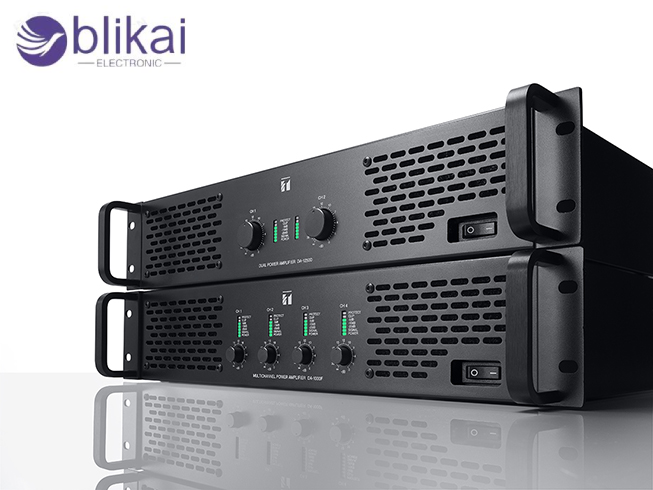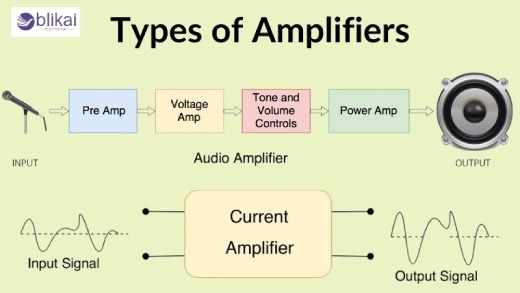What Do Amplifiers Do? Everything You Need to Know
What are Amplifiers?
An amplifier is an electronic device used for amplifying the amplitude of electrical signals. The weaker input signal might be audio, voltage or radio signal that shall then undergo amplification to a certain value without least affecting other parameters like the frequency and phase.

How Do Amplifiers Work?
Amplifiers amplify the strength of incoming signal by means of an external power source. They take inputs from any signal source, such as a microphone or sensor, amplify the signal using transistors, tubes, or other components, and then send out a stronger version.
Key Process in Amplification:
1. Input signal: A weak electrical signal enters the amplifier.
2. Power supply: The amplifier draws energy from a power source.
3. Amplification stage: Transistors or operational amplifiers (op-amps) increase the amplitude.
4. Output signal: The amplified signal is sent to an output device (like speakers or antennas).
Types of Amplifiers
Amplifiers are categorized based on their function and the type of signal they amplify.
1. Voltage Amplifiers
Voltage amplifiers increase the amplitude of input voltage signals. They are used in audio systems, instrumentation, and communication circuits to enhance weak signals for further processing.
2. Current Amplifiers
Current amplifiers boost input current signals and are applied in power electronics and motor control systems, where high current levels are necessary to drive loads.
3. Power Amplifiers
Power amplifiers are the high-power amplifiers used for driving heavy loads of big powerful speakers or RF antennas. They are in audio systems, radio transmitters, and industrial applications.
4. Operational Amplifiers (Op-Amps)
Op-amps are versatile, high-gain amplifiers used in signal conditioning, filtering, and mathematical operations. They are integral to analog computing, active filters, and control systems.
5. Differential Amplifiers
Differential amplifiers amplify the difference between two input signals and reject common noise. They are very widely used in instrumentation and sensor interfaces on precision measurements.
6. Audio Amplifiers
Audio amplifiers process the sound signals to enhance the sound quality in home theaters, headphones, and musical instruments. They combine both preamplifiers and power amplifiers, thus contending for the entire audio signal properties.
7. Radio Frequency (RF) Amplifiers
RF amplifiers operate to amplify high-frequency radio frequency signals for the purpose of proper communication and broadcasting. They are crucial in smartphones, satellite systems, and wireless networks to maintain strong signal strength over distances.

Classes of Amplifiers
Amplifiers are also classified based on their efficiency and linearity.
- - Class A: High linearity, poor efficiency (used in high-quality audio systems)
- - Class B: Moderate linearity, better efficiency (common in radios)
- - Class AB: Compromise between A and B, used in audio power amps
- - Class D: Very high efficiency, used in modern audio systems
Key Components in Amplifiers
1. Transistors: Control current flow and provide amplification.
2. Vacuum Tubes (for old-school amps): Used in vintage and high-end audio equipment.
3. Op-Amps: Used in signal processing for precision applications.
4. Transformers: In audio amps to adjust impedance or isolate signals.
Applications of Amplifiers
1. Audio Amplification: Amplifiers are basically devices facilitating audio transmission such as weak signals toward the amplifiers are used to drive the speakers. This helps in enhancement from general home audio, musical instruments, and public address systems. Bi-directional amplifiers take weak signals and amplify without distortion to ensure that the output signal is clear and strong. This also makes for better-living listening experiences.
2. Signal Processing: Amplifiers are used in telecommunications for amplifying signals processed by devices connected with antennas. It serves to clarify transmission over long-distance communication. Applications are vital to radio, television, and related telecommunication systems-aiding reliable and high-quality connections for voice and data transmissions.
3. Measurement Systems: Amplifiers are very vital in measurement and instrumentation systems, as they take care of amplification of each signal from the sensor to guarantee readings are correct. For example, they help improve the measurement system's precision capabilities by making it sensitive and enabling checking with an ultrasonic sensitivity in temperature, humidity, or pressure distribution with high precision.
4. Medical Equipment: In medicine, amplifiers are used in ECG and EEG machines among others. They boost bioelectric signals from the body for a precise diagnosis and monitoring of a patient. This application is vital for effective treatment plans and patient care in clinical settings.
5. Control Systems: Amplifiers are integral to control systems in industrial automation. Their amplification is usually done involving feedback signals from sensors, which control actuators working the machine itself. Enhancing the response and operational efficiency results in productivity and reliability.
6. Instrumentation: In scientific research, amplifiers are used in various instrumentation applications, including spectroscopy and chromatography. They enhance the detection of weak signals from detectors, allowing for more accurate data collection and analysis. This application is critical for advancing scientific knowledge and technological development.
Amplifiers in Everyday Life
1. Home Entertainment: Amplifiers serve to amplify the signals coming from audio-video devices such as the television set, Blu-ray players, and computer streaming services. In this way, they deliver full high-fidelity sounds through speakers, enhancing the viewing-listening experience and giving luxury to films and music alike.
2. Home Security Systems: In the field of home security, amplifiers increase the amplitude of signals from camera installations and motion detectors. This enhances the clarity of surveillance footage and alarm signals, thus aiding in ensuring that homeowners receive notice should a threat materialize. This application thus contributes to a safer living for families or householders.
3. Hearing Aids: It would be fair to say that amplifiers play an extremely important role in hearing aids-aids for amplifying all sorts of sounds to provide assistance to an individual with hearing impairment. These have proved invaluable for improving the quality of life of these people by helping them interact in social situations through conversation and discuss matters.
4. Smart Devices: Smart home technology includes the utilization of amplifiers across various devices, such as smart speakers and voice assistants. They boost audio output for music playback and voice recognition, thus facilitating seamless interactions with technology. This integration contributes to the convenience and functionality of modern living.
Advantages of Amplifiers
1. Signal Strength Enhancement
The purpose of amplifiers is to boost low-level signals to make them suitable to be worked on or transmitted efficiently. The importance of this increase cannot be understated, especially in applications like audio systems and telecommunications, where signal integrity is a crucial part of performance.
2. Improved Signal Quality
By amplifying signals without significantly increasing noise, amplifiers enhance overall signal quality. This characteristic is particularly important in precision measurement systems and high-fidelity audio equipment, where clarity and accuracy are paramount for optimal performance.
3. Increased Output Power
Amplifiers can drive speakers and other loads with higher power, enabling better sound projection in audio systems. This capability ensures that sound levels can be adjusted for larger spaces without distortion, improving user experience and engagement.
4. Flexible Design Options
With various configurations available, amplifiers can be tailored to meet specific requirements in electronic circuits. Designers can choose from operational, audio, and RF amplifiers, allowing for optimized performance based on the unique demands of each application.
Faqs
What is the difference between voltage and current amplifiers?
- Voltage Amplifier: Primarily increases voltage levels while maintaining current levels.
- Current Amplifier: Increases current levels, often used to drive low-impedance loads.
How do I choose an amplifier for my application?
Consider factors such as:
- - Required gain and bandwidth
- - Load impedance
- - Power supply voltage
- - Efficiency and thermal management
- - Cost and availability
What is the significance of the power supply in amplifiers?
The power supply supplies the voltage and current necessary for proper amplifier usage. A high-quality power supply will enhance the stability, performance, and noise manipulation capabilities of the amplifier.
Can amplifiers be used in both audio and RF applications?
Yes, amplifiers are increasingly designed for various applications. Audio or sound reinforcement amplifiers, on the one hand, on the other hand. RF amplifiers, for instance radio frequency amplifiers, meet very specific needs and vary accordingly in their design considerations.
Conclusion
Amplifiers are essential in the modern electronics landscape. From amplification of audio signals in sound systems to the transmission of radio waves across the globe, they enable devices to operate efficiently and effectively. Knowledge about their types, specific functions, and varieties of applications helps to appreciate the role of amplification in everyday life and sophisticated technology.
Related Articles
TDA2005 Amplifier: Working Principle and Applications
Integrated Amplifier: Types and Application (2024)
Buffer Amplifier: Types, Working Principle and Applications
LTC2055 Amplifier:Description,Features & Applications
What Integrated Amplifier Is and How It Works
LM386 Audio Amplifier Circuit: Features, Applications and Datasheet
Push-pull Amplifier :Overview and Working Principle
What is TL074 Operational Amplifier?
What is Buffer Amplifier?
Difference Btween Amplifier and Current-Sense Amplifier
What Is An Amplifier for?
Principle, Structure and Fault Analysis of Centrifugal Switch
The Ultimate Guide to CR1220 Battery
2N3904 vs 2N2222:What You Need to know
A Primers on Circulator and Isolators
Varieties of Electrical Wires and Cables










